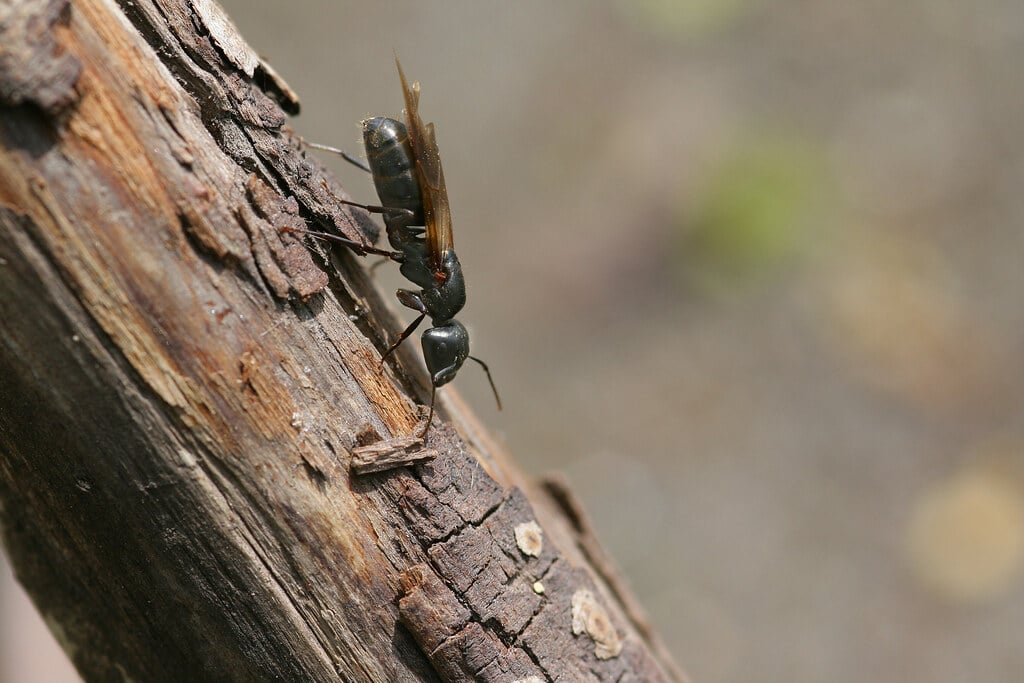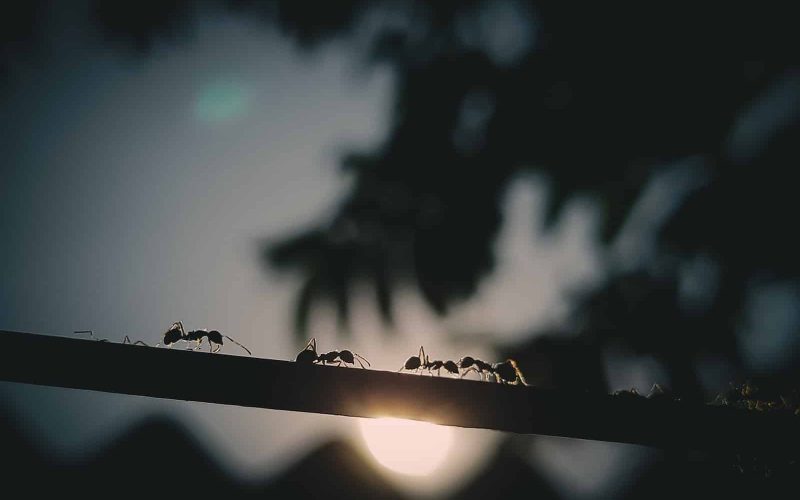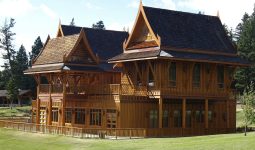Ants are one of the most common household pests, but many types of ants exist.
Each type of ant has its unique characteristics, behaviors, and habits.
Knowing the different types of ants in your home can help you identify and control them more effectively.
Therefore, we have discussed the different types of ants in a house in this article to help you understand them better.
1. Carpenter Ants

Carpenter ants in the US tend to be some of the biggest of their kind and are often in black or dark brown colors.
You can identify them by their large size and tendency to nest in decaying wood.
While most carpenter ant species have no intention of living inside human homes, some species may try to make a home inside your house.
If you see the carpenter ant coming in and out of your door frames, likely, they have already established a nest within the structure of your home. Though they don’t cause obvious damage, they can be a nuisance.
So, to prevent them from entering your home, seal off any cracks around windows and doors where they may enter.
Also, removing any decaying wood from your property will help discourage the carpenter ant from nesting near your house.
2. Pavement Ants
The name “pavement” has already secured its place among the different types of ants in a house.
Pavement ants are throughout the United States and get their name from their habit of making nests in or under cracks in the pavement.
These ants can also infest structures by entering through holes in the concrete.
Although these ant species do not pose a public health risk, they can contaminate food, so you should avoid them.
These ants are omnivorous, meaning they feed on plant and animal matter.
They eat almost anything, including other insects, bread crumbs, pet food, and even dead insects.
Pavement ants can also cause damage to plants by feeding on their roots and stems.
Besides, these ants can become a nuisance when they enter homes or other buildings looking for food sources.
To prevent an infestation of pavement ants, seal any cracks or crevices around the foundation of your home or building and any openings where pipes enter the structure.
Also, remember to keep all food sources sealed tightly so that these pests cannot access them.
3. Odorous House Ants
Odorous house ants are one of the most common among the different types of ants in a house.
They are small, dark brown, or black and often run along floorboards or on counters. These ants enter homes looking for food or a dry place to stay during wet weather.
They have earned their unusual name because they give off an odd smell when crushed. Some people describe this smell as like blue cheese or something rancid like rotten coconut.
Odorous ants can be difficult to get rid of since they reproduce quickly and can spread throughout the home if not dealt with properly.
4. Worker Ants
Worker ants are female ants who never reproduce. They gather food, care for the young, and defend the colony.
Worker ants are usually smaller than other ants and can be found in various colors, including black, brown, red, and yellow.
These ants are often seen carrying food back to their nest or marching in long lines across your floor.
They can enter homes through cracks in walls or windowsills and can be a nuisance if not dealt with properly.
Furthermore, worker ants have strong jaws and mandibles used for carrying food and constructing the nest and can live from several months to several years, depending on the species.
5. Crazy Ants
Among the different types of ants in a house are the crazy ants. The Caribbean crazy ant is a common ant species in the United States.
These ants are dark brown to black with a gray sheen and range from 1/16-1/8 inch in size.
They got their name from their habit of running around erratically when searching for food.
Crazy ants are highly adaptable to dry and moist habitats. Also, they tend to enter homes in the autumn or after rainfall because these conditions reduce the supply of honeydew, which is their main food source. Inside, they usually nest underneath floors or carpeting.
It is important to take steps to prevent an infestation of these ants, as they can cause significant damage if left unchecked.
6. Ghost Ants
Ghost ants are also among the different types of ants in a house. These ant species have multiple queens and nests, making them highly mobile.
Thus, it isn’t easy to control their colonies as direct-nest spray treatments may not contact all members of the interrelated colonies.
Ghost ant colonies also reproduce through budding, making the same pest control approaches effective for ghost and pharaoh ants.
The most common way to control ghost ant populations is by using baits or insecticides. You can place baits near nests or trails.
This will attract the worker ants, who will then take the bait back to the nest and share it with other colony members.
You can also use insecticides to ensure that all colony members are contacted. Note that you may need to repeat these methods several times for them to be effective in controlling ghost ant populations.
7. Grease Ants
Grease ants are a common household pest. These small ants are often found nesting indoors and can be difficult to eliminate. Yet, baiting works for them.
Place a small amount of greasy bait near the areas where they have been spotted. The bait will attract the thief ants, and they will take it back to their nest, eliminating them from your home.
When controlling grease ants outdoors, baits are not effective since the ant is nesting outside.
To locate an outdoor nest, you must follow the trail of ants backward from the food source.
Once you have located the nest, you can treat it directly with insecticides or other methods, such as boiling water or diatomaceous earth.
These steps can eliminate thief ants from your home and keep them away for good.
8. Fire Ants
You’ll find fire ants among the different types of ants in a house. They are a species of ant native to the southern United States from Maryland to Texas, California, and New Mexico.
Fire ants build their nest mounds outdoors in landscape areas or near a structural foundation and can also gain entry to a building through holes or cracks in the exterior structure.
When their nests are disturbed, red imported fire ants will attack with a painful sting, often resulting in a raised welt that becomes a white pustule.
These stings can be very painful and cause an allergic reaction in some people.
Thus, you must take precautions when dealing with these pests, such as wearing protective clothing and using insecticides if necessary.
9. Rover Ants
Rover ants are a fascinating species of insect that can often be seen scurrying across kitchen counters in search of food.
These tiny creatures, measuring only one-sixth of an inch in length, range in color from dark brown to pale blonde.
Also, they usually congregate in large numbers around food sources such as sugar jars or honey lids.
These ants can traverse long distances quickly and efficiently, making them ideal for scouting new food sources.
They also possess a unique navigational system that allows them to find their way back home after a successful mission.
Rover ants are incredibly resilient and hardy creatures, easily surviving even the harshest conditions.
This makes them a great addition to any ecosystem, as they help control other insect populations while providing valuable soil nutrients.
While they’re all this great stuff, they’re unwanted in the house. To get rid of rover ants, you can place baits near the ant trails and around the perimeter of your home to keep them from entering.
10. Argentine Ants
Argentine ants are the last on our list of the different types of ants in a house.
They were accidentally introduced from Argentina and have since formed giant supercolonies along the coast of California.
Argentine ants are typically medium-sized and dark brown and usually nest outside.
However, they will take advantage of any sugary sources or crumbs left in the kitchen and come inside looking for water.
Sometimes, many of these ants will be indoors, but they may not always appear.
They usually come indoors in the springtime when it’s raining, seeking dry environments to establish new dwellings.
Argentine ants can be difficult to eliminate once they have established themselves in an area.
So, it’s important to take preventative measures such as sealing off entry points into your home and keeping food sources out of reach.
Bottom Line
We hope you fully understand the different types of ants in a house. Fire ants, rover ants, and Argentine ants are the most common species that can be found in homes.
Do you have any thoughts regarding this? Share with us in the comments section.








